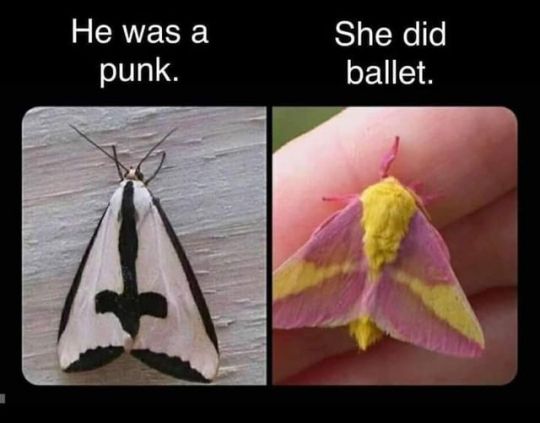#karole armitage
Explore tagged Tumblr posts
Text













Dance 2wice
edited by Patsy Tarr and Abbot Miller, texts by Nancy Dallva
Phaidon, London 2004, 160 pages, 22x30cm, ISBN 0-7148.4365-2
euro 40,00
email if you want to buy [email protected]
Dance 2wice is a collection of unique photographic essays depicting contemporary dance. Distilled from the pages of the award-winning disciplinary arts journal 2wice, the images explore the dynamic dialogue between performance and photography and bring together the talent of some the world's most respected dancers, choreographers, and photographers. In these carefully conceived collaborations, the transitory art of such key contemporary dance figures as Merce Cunningham, Mark Morris, Paul Taylor, and Karole Armitage is vividly captured: The pages become the stage for beautifully choreographed performances.
01/11/24
#Dance 2wice#contemporary dance#2wice#Merce Cunningham#Mark Morris#Paul Taylor#Karole Armitage#fashionbooksmilano
13 notes
·
View notes
Text

Chain of Desire (1992)
by Temístocles López
#1990s movies#Karole Armitage#linda fiorentino#La Ronde#kevin conroy#elias koteas#Dewey Weber#Downtown NYC
6 notes
·
View notes
Photo

karole armitage and jean-marie didière photographed by courtesy of jean-marie didière
18 notes
·
View notes
Photo

4 notes
·
View notes
Text








Doctor Who: The Macra Terror (4.7, BBC, 1967)
"Now, come along, Polly. I'm sure there's no need to be afraid. Well... well, I think there's no need to be afraid. Oh, come on, let's find out."
#doctor who#classic doctor who#the macra terror#bbc#1967#two#patrick troughton#ian stuart black#john davies#anneke wills#michael craze#frazer hines#peter jeffrey#graham armitage#ian fairbairn#jane enshawe#sandra bryant#karol keyes#luan peters#terence lodge#gertan klauber#graham leaman#anthony gardner#ever since i was a very small dw fan‚ I've had an inexplicable attachment to the Macra. i can't really explain it‚ perhaps i saw a#production still or something... still‚ to pin my affections on a one shot monster from an entirely lost serial.. but what surprises the#years bring‚ and here i am in 2022 able to watch a fully animated version of my beloved crab monster story. what strange joys life can#deliver. the plot remains as good as it did on audio all those years back (an unfairly overlooked story which plays with cold war themes of#brainwashing and governmental suppression in a sci fi setting). i think the macra probably distracted from the script and the excellent#guest performances (Peter Jeffrey my beloved! the animation captures him quite well by the by)(unlike poor Anneke who gets something of a#bum deal). but yes‚ a fun time‚ and what joy to finally see it in true motion... how my macras scuttle...i love them
37 notes
·
View notes
Text
Peter Speliopoulos, nato nel 1961 a Springfield, nel Massachusetts, è uno stilista americano.

Peter Speliopoulos è nato nel 1961 in Grecia. I suoi genitori greci viaggiavano costantemente tra New York e Parigi. Trascorse la sua infanzia a Springfield nel Massachusetts e infine si stabilì a New York. Speliopoulos ha studiato moda alla Parsons School of Design di New York e si è laureato con un BFA nel 1981. Peter è il migliore amico dello stilista Isaac Mizrahi che ha anche frequentato Parsons. Il suo primo lavoro come stilista è stato come assistente stilista con Laura Biagiotti a Roma nel 1982. Ha poi lavorato brevemente nella casa di moda francese di Christian Dior e successivamente per la designer di abbigliamento sportivo di New York Gloria Sachs la cui etichetta è fallita nel 1992. Nel 1985, Speliopoulos è stato nominato direttore creativo di Carolyne Roehm Inc., una casa di moda di New York che è stata creata nel 1984. Ha lasciato nel 1991 per diventare direttore della moda con Joseph Abboud.
Dal 1993 al 1997, Speliopoulos ha lavorato come designer per Donna Karan a New York. Ha sostituito Narcisco Rodriguez a capo del design per la collezione femminile di Nino Cerruti a metà del 1997. Durante la sua permanenza in Cerruti, ha donato all’etichetta un aspetto fresco e moderno, utilizzando dettagli e tessuti raffinati. Ha lasciato Cerruti nel 2002 per tornare a New York come Vice Presidente del Design per Donna Karan New York. Da allora è rimasto con Donna Karan, una casa di moda di proprietà del gruppo francese LVMH .

Speliopoulos ha anche lavorato come costumista per Karole Armitage, una ballerina di New York proprietaria di una compagnia di ballo. Nell’estate del 2000, ha disegnato i costumi per la produzione dell’Opera di Atene di The Birds di Aristofane. La collaborazione con Armitage è continuata fino al 2003. Ha anche lavorato come costumista con la Rambert Dance Company di Londra per la quale Karole Armitage è stata coreografa.

Peter afferma di essere sempre ispirato dalla costruzione di Balenciaga, dall’essenzialissimo di Halston e dal genio di Yves St. Laurent. Cerca di rendere i suoi capi un mix di sensualità femminile e sartoria maschile, creando versatilità nel guardaroba di una donna.
Sebbene abbia studiato ceramica dal 2011, Speliopoulos ha deciso di dedicarsi ad essa solo dopo la chiusura di Donna Karan nel 2015. Ha lavorato creando crepe e smalti, ma ben presto si è reso conto di quanto gli mancassero i suoi legami con l’Italia e l’atelier di tessuti.
Speliopoulos è stato a lungo un pilastro nel mondo della moda, negli ultimi anni, tuttavia, è passato dai tessuti pregiati all’argilla.

Speliopoulos – insieme al suo partner da oltre 20 anni, Robert Turner – è donatore del Fondo annuale Friends for Life presso il GMHC.
aggiornato al 17 ottobre 2019
Autore: Lynda Di Natale Fonte: wikipedia.org, web
Peter Speliopoulos #peterspeliopoilos #speliopoulos #creatoredellostile #creatoredellamoda #perfettamentechic #felicementechic #lynda Peter Speliopoulos, nato nel 1961 a Springfield, nel Massachusetts, è uno stilista americano. Peter Speliopoulos…
#Carolyne Roehm Inc.#Christian Dior#Donna Karan#Isaac Mizrahi#Joseph Abboud#Karole Armitage#Laura Biagiotti#Lvmh#Narcisco Rodriguez#Nino Cerruti#Peter Speliopoulos#Rambert Dance Company#Robert Turner#Speliopoulos
0 notes
Video
tumblr
SophiaBush: It’s a #TuesdayTune kind of afternoon, courtesy my lady love @lpx 🔥🔴🔥
•
#repost @lpx
•
Tightrope is about wrestling with the dizzying highs and lows of throwing oneself wholly with heart, body and mind, towards a risk. For the video I wanted to explore translating that internal battle into a physical one while highlighting the intensity and frenetic energy of the song. I was lucky enough to work with legendary choreographer Karole Armitage, a dance revolutionary and the original punk ballerina, who worked on iconic videos like “Vogue” by Madonna and Michael Jackson’s “In the Closet.” Together we crafted the piece to show the torment, triumph and struggle of being all consumed with obsession, desire and doubt where the dance is equal parts resistance and perseverance. I hope it releases you from reality and inspires🌹 🎥 x @mafalda_millies 💃🏻🤘🏻#KaroleArmitage
6 notes
·
View notes
Text

#star wars#star wars saga#star wars franchise#star wars prequel trilogy#star wars prequels#prequel trilogy#star wars episode i the phantom menace#the phantom menace#george lucas#padme amidala#natalie portman#jar jar binks#ahmed best#sabe#Keira Knightley#rabe#karol christina da silva#captain panaka#hugh quarshie#richard armitage
5 notes
·
View notes
Text



Christian Lacroix: Costumier
EXHIBITING FASHION
Start Date: 03 JUNE 2007
End Date: 11 NOVEMBER 2007
Venue: CENTRE NATIONAL DU COSTUME DE SCENE
Location: MOULINS, FRANCE
Curator: CHRISTIAN LACROIX AND DELPHINE PINASA
Designer: MICHEL ALBERTINI
Couture
Designer Histories
How does a great couturier dress the stage? How does a magician of colours, a lover of shimmering fabrics, a sculptor of shapes and volumes, an alchemist of laces, braids, ruches and other frivolities transform artists by giving their dress to the characters of choreographic works, lyrical and theatrical performances performed on the biggest national and international stages?
For more than twenty years, even before the creation of his fashion house, Christian Lacroix has been working with constant happiness behind the scenes of theatre workshops, combining the science of haute couture technique and artisanal know-how, tips and tricks of the stage, respect for the works and personal sensitivity.
Christian Lacroix likes to evoke his first steps in sewing, while from his early years, returning from the theatre, he reinterpreted the costumes he had just seen on the set.
As an echo to this initial vocation, the Center national du costume de scène is organizing the first major event around the work of Christian Lacroix for the show.
This exhibition presents more than 200 costumes and models of costumes created by Christian Lacroix and performed in specialized sewing workshops in the performing arts. A panorama of more than twenty-five ballet, theatre and opera productions, among which:
For the ballet: “Gaité parisienne”, choreography by Mikhaïl Barysnikov for the American Ballet Theatre in New York; “Les Anges ternis”, choreography by Karole Armitage; “Shéhérazade”, choreography by Blanca Li for the Opéra national de Paris; “Cinderella” at the Vienna Opera; “La Valse des bonbons”, for Austrian television.
For the theatre: “Chantecler” , directed by Jean-Luc Tardieu for the Maison de la Culture in Nantes; “Otello et Phèdre”, two productions by Anne Delbée for the Théâtre 14 and the Comédie-Française in Paris; “Les Caprices de Marianne”, directed by Lambert Wilson at the Bouffes du Nord.
For the opera: “Carmen” , directed by Antoine Bourseiller at the Arènes de Nîmes; “Cosi fan tutte”, “Il Re pastore”, “Eliogabalo”, three operas directed by Vincent Boussard for the Théâtre de la Monnaie in Brussels.
Images courtesy of Centre National du Costume de Scene
#Christian Lacroix#Costumier#Costume History#Christian Lecroix: Costumier#Exhibiting Fashion#03 June 2007#11 November 2007#Centre National du Costume de Scene#Moulins#France#Christian Lacroix and Delphine Pinasa#Michel Albertini#Couture#Designer Histories#Costume#Couturier#Gaité parisienne#Mikhaïl Barysnikov#American Ballet Theatre#New York#Les Anges ternis#Karole Armitage#Shéhérazade#Blanca Li#Opéra national de Paris#Cinderella#Vienna Opera#La Valse des bonbons#Australian Television#Cantecler
5 notes
·
View notes
Text
Profiles of Pride: June 25th! 🏳️🌈Willi Ninja🏳️🌈
William Roscoe Leake (April 12, 1961 – September 2, 2006), better known as Willi Ninja, was an American dancer and choreographer best known for his appearance in the documentary film Paris Is Burning.
Ninja, a gay man known as the godfather of voguing, was a fixture of ball culture at Harlem's drag balls who took inspiration from sources as far-flung as Fred Astaire and the world of haute couture to develop a unique style of dance and movement. He caught the attention of Paris is Burning director Jennie Livingston, who featured Ninja prominently in the film. The film, a critical and box office success, served as a springboard for Ninja. He parlayed his appearance into performances with a number of dance troupes and choreography gigs. The film also documents the origins of "voguing", a dance style in which competing ball-walkers freeze and "pose" in glamorous positions (as if being photographed for the cover of Vogue magazine). In 1989, Ninja starred in the music video for Malcolm McLaren's song "Deep in Vogue", which sampled the then-unfinished movie and brought Ninja's style to the mainstream. One year after this, Madonna released her number one song "Vogue", bringing further attention to the dancing style.
He participated in Harlem's drag balls with "children" from his House of Ninja. Like other ball "houses", HoN was a combination of extended social family and dance troupe, with Ninja as its Mother. He taught his "children" late into the night on the old Christopher Street pier and at the underground clubs.
Ninja was a featured dancer in many music videos including Malcolm McLaren's "Deep in Vogue" and "I Can't Get No Sleep" by Masters At Work featuring India. In 1994, he released his single "Hot" (another Masters At Work production) on Nervous Records. Ninja's later career included runway modeling for Jean-Paul Gaultier, performing with dance companies under Karole Armitage, and providing instruction to Paris Hilton on perfecting her walk. He opened a modeling agency, Elements of Ninja, in 2004, and made an appearance on Jimmy Kimmel Live!. Ninja was also prominently featured in the 1990 documentary Paris is Burning and the 2006 documentary release How Do I Look directed by Wolfgang Busch.
Ninja also danced in two of Janet Jackson's videos from her album Rhythm Nation 1814, one of which was "Alright", whose remix featured late rap star Heavy D and cameo appearances by Cab Calloway, Cyd Charisse, and The Nicholas Brothers. He also was featured in "Escapade".
Ninja worked hard to care for his mother, Esther Leake, who had Parkinson's and used a wheelchair. Her trips with Ninja to the ballet and the Apollo were inspiration for his later endeavors in dance.
Willi Ninja started the House of Ninja in 1982, with Sandy Apollonia Ninja, despite not having been part of a house previously or winning three grand prizes, which was generally seen as a requirement to start a house. The name Ninja came from the house's Asian and martial arts influences coupled with the fact that people in the ballroom scene did not know who they were and they “seemed to come out of nowhere”. The House of Ninja had a reputation for being multiracial; most houses at the time were African-American, with the notable exception of the Latino House of Xtravaganza. The House of Ninja notably included white men in their competitions. The house closed in 1989 and reopened for a second time in 1991 and reopened a third time by 2003. The House of Ninja currently has over 220 members worldwide. The oldest living Ninja is Archie Burnett Ninja.
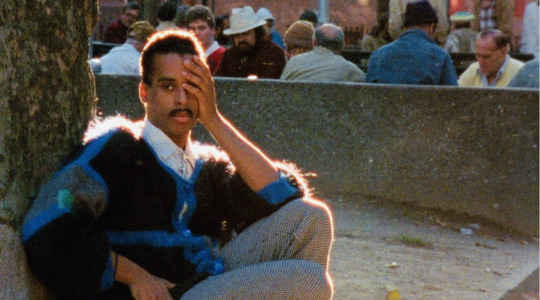
#Willi Ninja#Profiles in Pride!#Pride Month#Pride#LGBTQIA+#LGBTQIA+ Rights#LGBTQIA+ Pride#June#June 25th#House of Ninja#HoN#William Roscoe Leake#William Leake
5 notes
·
View notes
Photo

Rave, 2001
by Karole Armitage
2 notes
·
View notes
Photo

(via At home exercises from ‘punk ballerina’ Karole Armitage)
1 note
·
View note
Photo

Emily Wagner and Ruka Hatua-Saar in Karole Armitage’s Life Story, White Light Festival, November 2015. © Foteini Christofilopoulou.
Dating from 1999, Armitage’s work for two dancers is set to a piece by Adès for piano and soprano-singing of Tennessee Williams’ eponymous poem about the ubiquitous one-night stand. Ruka Hatua-Saar performed with a rather (perhaps over) animated Emily Wagner while Anna Dennis sang the words from Williams’ darkly comic, cynical and too true poem.
8 notes
·
View notes
Link
0 notes
Text
After 30 Years of Scrutiny, David Salle’s Paintings Still Confound

David Salle, Mingus in Mexico, 1990. Courtesy of the artist and Skarstedt Gallery.
It’s only natural to desire a simple, straightforward narrative. Artworks (and people) that seem to proffer easy interpretation, then deny any satisfying conclusion, are eminently frustrating. For over 40 years, the artist David Salle has been making work—and giving interviews—that deny tidy conclusions.
Though Salle began exhibiting in New York in the 1970s, it was his association with Mary Boone that launched his career. The gallerist first displayed his work in a 1980 exhibition alongside that of painters Julian Schnabel and Ross Bleckner. New York’s critical and financial attention fixated on the trio throughout the rest of the decade.
A widely accepted story developed: the so-called “return to painting” in the 1980s. The Whitney Museum played on this trope when it organized last year’s “Fast Forward: Painting from the 1980s.” Tate Modern operated on similarly reductive assumptions in its 2008–09 exhibition “UBS Openings: Paintings from the 1980s.” Both shows romantically posited a decade-long surge in exciting, innovative painting in New York that coincided with an eager, receptive market. The shows alternately grouped together such disparate artists as Mary Heilmann, Jean-Michel Basquiat, and Salle himself.
Salle, however, disagrees. “I don’t put a lot of store into art world narratives,” he tells Artsy. “People aren’t very observant. They like to repeat stuff that sounds provocative.” He admits there was a “tremendous shift in emphasis” during the decade, that socio-economic changes during the 1970s led to something in the 1980s, though he doesn’t quite articulate what that is. Salle is content with the slight contradiction.
While he might normally ignore the art world’s narratives, Salle does take stock in the idea of a “Pictures Generation.” In 1977, critic Douglas Crimp organized an exhibition called “Pictures” at Artists Space in Lower Manhattan. In the catalogue, Crimp described our increasing reliance on media images: “While it once seemed that pictures had the function of interpreting reality, it now seems that they have usurped it,” he wrote. A new wave of artists were using found images and photographsin their work to challenge preconceived beliefs about what they signified. The Pictures Generation, which took its name from the show, grew to include such figures as Cindy Sherman (who created “film stills” sans films), Richard Prince (who photographed magazine advertisements, claiming the results as his own artwork), and Salle himself.
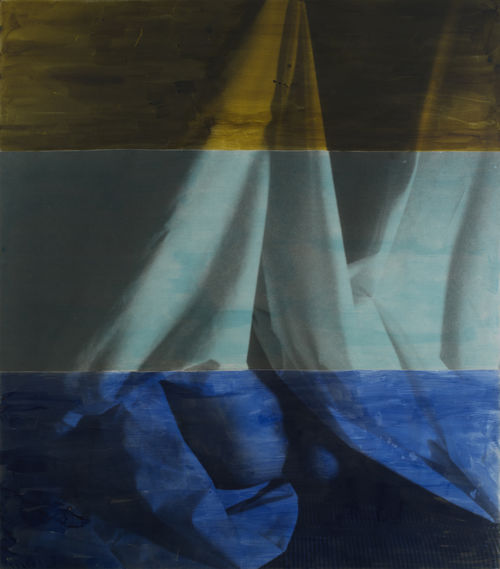
David Salle, Ghost 4, 1992. Courtesy of the artist and Skarstedt Gallery.

David Salle, Open Boat, 1992. Courtesy of the artist and Skarstedt Gallery.
For the first time in art history, says Salle, a number of artists’ orientation to the visual world was “to the page.” He and the Pictures Generation took after Andy Warhol and the Pop artists as they manipulated popular media for their own work. Like Prince, Salle briefly worked at a magazine company in the 1970s. “There wasn’t a single photographer on staff,” he recalls. Instead, they used “slightly campy stock photographs.” These shots were increasingly devoid of meaning; when the magazine shuttered, they literally became trash.
After he left the publication, Salle himself “quoted” found images and other artists’ styles in his paintings, offering little to no hint of where he got them. The obscured sources could turn the works into impossible guessing games.
Take Old Bottles (1995), for example, which is on view at Skarstedt Gallery through June in a new exhibition surveying the artist’s work from 1985 through 1995. Attempt to reconcile, without floundering, the collaged pictorial elements that make up the painting: clenched fists; cups and bottles; butterflies, snowflakes, a train, the backs of two women. Hypothesizing where these images are from, and what they mean, becomes an infuriating exercise. Salle himself has suggested it’s more fruitful to look at a painting’s structure, rather than its component parts. Still, it’s easy to get stumped.
The Skarstedt exhibition highlights works from not just the decade with which Salle is most associated, but from the 1990s, as well. “Life continued after the 1980s, as inconvenient as that might be for some people,” the artist says (he kept painting, disregarding claims that his heyday was over—indeed, he’s still making and exhibiting new work today).
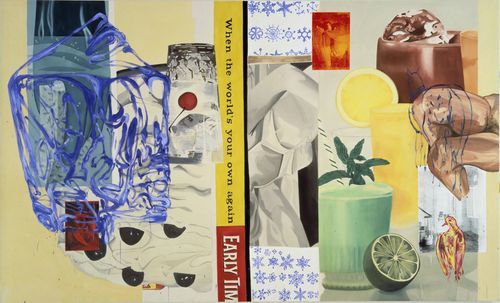
David Salle, Final Cut, 1993. Courtesy of the artist and Skarstedt Gallery.
During the late 1980s, Salle turned to new sources; collaborations with the American Ballet Theater generated crucial material and ideas. Salle created costumes and sets for a Mikhail Baryshnikov ballet and a number of other productions choreographed by Karole Armitage (the pair were also romantically linked).
Indeed, a sense of theatricality pervades the works on view at Skarstedt. The depicted folds in Ghost (1992) resemble those of a fallen curtain. It’s divided into three bands of color, suggesting the typical three-act structure of a stage production. Open Boat, from the same year, has the feel of a dark prop closet filled with objects incoherently discarded and jumbled together, seen outside of their original contexts (an apt metaphor for much of Salle’s painting). Like Stephen Crane’s 1897 short story of the same title, which explored the unknowability of the natural world, the painting suggests that interpretation is probably futile.
Salle’s engagement with the performing arts, combined with his predominant interests in simultaneity and juxtaposition, eventually found a natural outlet in film. In 1995, he made his directorial debut with Search and Destroy, a movie about an aspiring filmmaker that featured Dennis Hopper, Rosanna Arquette, and Christopher Walken. Salle had been editing and splicing images together for years; now he was doing the same with live action reels.
The title of Salle’s painting Final Cut (1993) evokes the language of cinema. The vertical bar at the center neatly divides the canvas as though into two still frames. The painting has a sun-drenched, pop-infused look to it, the central text derived from a whiskey ad. With its light tones, depictions of cool drinks, and identifiable source material, the painting is perhaps the most inviting in the show.
There’s a spooky, chilly aura to the others. The most disturbing may be Fooling with your Hair (1985): In three distinct sections within the painting’s lower half, the viewer sees pictures of a woman in compromising positions on a thin table, unclothed from the waist down (except for a pair of shoes). The emphasis on light and shadow reminds us that these representations derive from black-and-white photography. The scenes look staged, eerie, repellent, and ultimately anti-erotic.
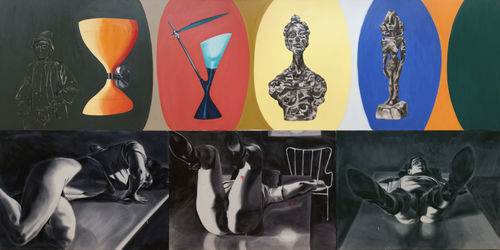
David Salle, Fooling with your Hair, 1985. Courtesy of the artist and Skarstedt Gallery.
Such depictions of women (or, depictions of photographs of women) have garnered Salle plenty of vitriol. In defending these works, he returns to his ideas about theatricality and his engagement with the ballet. He describes “directing a performer to occupy space in a certain way,” suggesting that he’s truly critiquing his photographic process, not women themselves.
Critics, including artist Mira Schor, weren’t accepting of such rationales. In a 1986 essay, Schor asked why Salle hadn’t “drawn and quartered” male nudes in the same way as he had female nudes. “Salle uses woman as a metaphor for death; woman has become a vehicle for the difficulty of painting,” she wrote. She criticized his supporters such as writer Carter Ratcliff, who had depicted Salle as “a self-conscious pornographer, one capable of embarrassment.” For Schor, that presented the artist as “a repentant rapist” who could be excused from culpability. Salle’s work, Schor suggested, invoked an exclusively male spectator.
Over the next few weeks, viewers will be able to judge for themselves. Salle himself hasn’t seen many of these paintings for decades, and even he’s not sure how they will fare. What matters to him is whether they still appear alive and vital. As for the show’s overall reception, the artistdoesn’t seem too worried. “It’s difficult to talk about the art world as a whole entity because it’s so fragmented,” he says. “You can’t really find six people to agree about anything.” Perhaps that, for Salle, is also its appeal.
from Artsy News
2 notes
·
View notes
